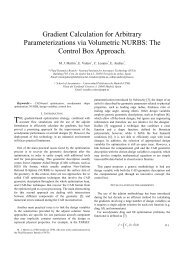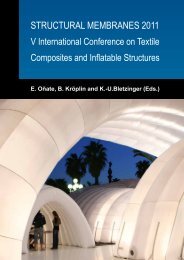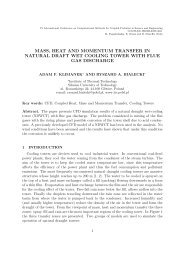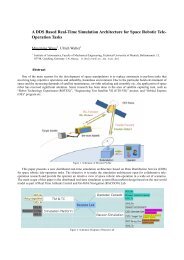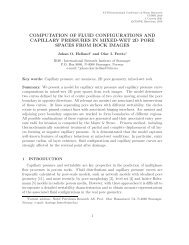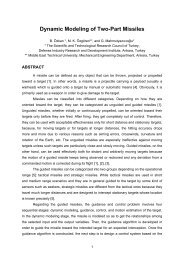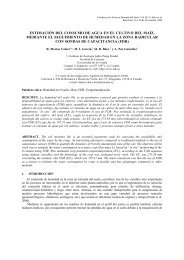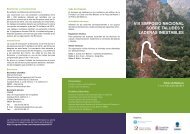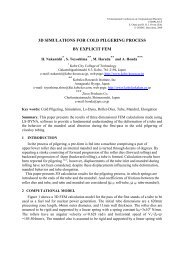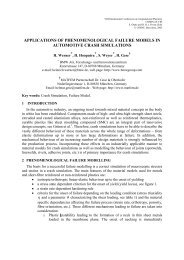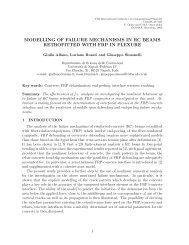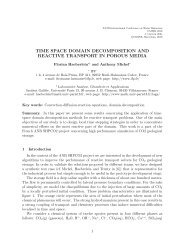proper orthogonal decomposition in direct and inverse elastic-plastic ...
proper orthogonal decomposition in direct and inverse elastic-plastic ...
proper orthogonal decomposition in direct and inverse elastic-plastic ...
You also want an ePaper? Increase the reach of your titles
YUMPU automatically turns print PDFs into web optimized ePapers that Google loves.
X International Conference on Computational PlasticityCOMPLAS XE. Oñate <strong>and</strong> D. R. J. Owen (Eds)© CIMNE, Barcelona, 2009PROPER ORTHOGONAL DECOMPOSITION IN DIRECT ANDINVERSE ELASTIC-PLASTIC ANALYSISGabriella Bolzon, Vladimir Buljak <strong>and</strong> Giulio Maier ** Dipartimento di Ingegneria Strutturale, Politecnico di MilanoPiazza Leondardo da V<strong>in</strong>ci 33e-mail: maier@stru.polimi.itKey words: <strong>in</strong>verse problems, parameter identification <strong>in</strong> metal <strong>plastic</strong>ity, simulation of<strong>in</strong>dentation test, Proper Orthogonal Decomposition, Radial Basis Function.Summary: With reference to <strong>in</strong>dentation tests on metal structures a material characterizationprocedure is proposed based on experimental date from both <strong>in</strong>dentation curves <strong>and</strong> impr<strong>in</strong>tprofile <strong>and</strong> on <strong>in</strong>verse analyses centered on Proper Orthogonal Decomposition, Radial BasisFunctions <strong>and</strong> Trust Region algorithm.1 INTRODUCTIONDeterioration of structural materials due to chemical <strong>and</strong> physical processes impliesreduction of mechanical <strong>proper</strong>ties such as <strong>elastic</strong> stiffness, yield limit <strong>and</strong> harden<strong>in</strong>gparameters. In order to assess the level of accumulated damage diagnostic analysis of<strong>in</strong>dustrial components may be required. Frequently <strong>in</strong> the real-life eng<strong>in</strong>eer<strong>in</strong>g practice,possibly deteriorated components are still <strong>in</strong> service <strong>and</strong>, hence, require non-destructive tests<strong>and</strong> diagnoses to be performed <strong>in</strong> situ. In order to perform the whole parameter identificationprocess rout<strong>in</strong>ely <strong>in</strong> situ, it is necessary to employ a fast numerical procedure for solv<strong>in</strong>g the<strong>in</strong>verse problem fed by data collected from experiments, like <strong>in</strong>dentation tests.In this communication it is shown that the computational burden associated with therepetitive simulations of such tests required by the algorithms for the m<strong>in</strong>imization of thediscrepancy function can be significantly reduced by an <strong>in</strong>terpolation procedure based onProper Orthogonal Decomposition (POD) comb<strong>in</strong>ed with Radial Basis Function (RBF). It isevidenced how prelim<strong>in</strong>arily performed simulations can be exploited to construct low-orderapproximations that can eventually be employed to compute the structural responsespractically without any loss of accuracy with significant reduction of comput<strong>in</strong>g time. Suchapproach is adopted here<strong>in</strong> for elasto-<strong>plastic</strong> <strong>in</strong>verse analysis where repetitive analyses of thesame system (namely the same geometry, same boundary conditions etc.) need to beperformed for numerous diverse sets of material parameters.2 DIRECT INELASTIC ANALYSIS BASED ON PROPER ORTHOGONALDECOMPOSITIONFor simulations of typical <strong>in</strong>dentation tests on a metal specimen by a conical <strong>in</strong>denter acommercial F<strong>in</strong>ite Element code (ABAQUS) us<strong>in</strong>g the model shown <strong>in</strong> Figure 1 have been
G. Bolzon, V. Buljak <strong>and</strong> G. Maier.adopted. The model exhibits the follow<strong>in</strong>g ma<strong>in</strong> features: axiall-symmetry; 1600 quadrilateralelements (each with 4 nodes); regime of large-stra<strong>in</strong> deformations; Huber-Mises elasto<strong>plastic</strong>itywithout harden<strong>in</strong>g (with parameters: Young’s modulus E=202GPa, Poisson’s ratioυ=0.3; yield limit σ Y =300MPa,); <strong>elastic</strong>ally deformable <strong>in</strong>denter with E=1170GPa <strong>and</strong> υ=0.1.Figure 1: F<strong>in</strong>ite Element model of the conical <strong>in</strong>dentation testTraditional <strong>direct</strong> analyses have been performed by attribut<strong>in</strong>g to parameters the follow<strong>in</strong>gset of values: Young’s modulus from 150GPa to 250Gpa with the step of 20GPa; yield limitfrom 150MPa to 400MPa with the step 25MPa. The results of these 66 <strong>direct</strong> analyses of<strong>in</strong>dentations (the so-called “snapshots”) are correlated as obviously expected, namely they arealmost parallel if represented as vectors. In what follows, the results <strong>in</strong> focus are von Misesequivalent stresses at Gauss <strong>in</strong>tegration po<strong>in</strong>ts, therefore 6400 components <strong>in</strong> each snapshot.The expected correlation suggests to apply the mathematical procedure usually calledProper Orthogonal Decomposition (e.g. 4 ). The procedure adopted can be outl<strong>in</strong>ed as follows:<strong>in</strong> the snapshot space (of dimensionality 6400) a new <strong>orthogonal</strong> system is determ<strong>in</strong>ed suchthat with respect to the first <strong>direct</strong>ion the sum of projections of all (66) snapshots atta<strong>in</strong>s itsmaximum; a second <strong>direct</strong>ion is characterized by the same maximum <strong>proper</strong>ty among the<strong>direct</strong>ions <strong>orthogonal</strong> to the first one, <strong>and</strong> so on. Such procedure implies the computation ofeigenvalues <strong>and</strong> eigenvectors of a matrix (symmetric <strong>and</strong> positive-semi-def<strong>in</strong>ite here withdimensions 66×66) generated from the matrix which gathers all snapshots as columns premultiply<strong>in</strong>gby its transpose. In the new reference system many components of the correlatedsnapshots are negligible. The computed eigenvalues can be used to select those which can beneglected (for details see 1,6 ). In order to computationally exploit for a new analysis thecompressed <strong>in</strong>formation extracted by the above POD procedure from the orig<strong>in</strong>al snapshots,<strong>in</strong>terpolation is now performed us<strong>in</strong>g Radial Basis Functions (RBF) specifically <strong>in</strong> the presentstudy <strong>in</strong>verse multiquadric (for details see 5 ).Us<strong>in</strong>g the above <strong>in</strong>terpolation procedure, the stress field generated by the <strong>in</strong>dentation testspecified <strong>in</strong> Section 2 has been computed start<strong>in</strong>g from a new pair of parameters, E=202GPa,σ Y =405MPa. The same field was computed by the conventional FE analysis through the2
G. Bolzon, V. Buljak <strong>and</strong> G. Maier.before mentioned commercial code. The two results exhibit differences of the order ofmagnitudes of 1/10 percent. The remarkable feature is that the ratio between comput<strong>in</strong>g timesof the two procedures turned out to be of the order of 10 5 <strong>in</strong> favour of the POD-RBF.3 INVERSE ANALYSES BASED ON PROPER ORTHOGONALDECOMPOSITIONThe numerical exercise outl<strong>in</strong>ed <strong>in</strong> Section 2 clearly evidences the significant potentialadvantages of the use of POD-RBF <strong>in</strong>terpolation for <strong>in</strong>verse analyses <strong>in</strong>tended to identifymaterial parameters <strong>in</strong> real life eng<strong>in</strong>eer<strong>in</strong>g practice on the basis of recurrent non-destructivetests, like <strong>in</strong>strumented <strong>in</strong>dentations which at present frequently replace the traditional harnesstests (see 2,3 ).Figure 2 shows typical experimental data provided by an <strong>in</strong>strumented <strong>in</strong>denter <strong>and</strong> by alaser profilometer, namely force vs. penetration curve (a) <strong>and</strong> impr<strong>in</strong>t profile (b), respectively.In the present computational exercise the sought material parameters are Young modulus,yield limit <strong>and</strong> harden<strong>in</strong>g coefficient. Other mean<strong>in</strong>gful features are as follows: FE modelsame as <strong>in</strong> Figure 1; snapshots prelim<strong>in</strong>arily computed by the model concern<strong>in</strong>g the follow<strong>in</strong>g“nodes” <strong>in</strong> the parameter space: Young modulus from 130 to 230 GPa, step 20 GPa; yieldlimit from 150 to 350 MPa step 25 MPa; harden<strong>in</strong>g exponent from 0 to 0.21 with the step0.01; the chosen RBF are mulriqudric as mentioned earlier. As measurable quantities, 100penetration depths (correspond<strong>in</strong>g to 100 chosen <strong>in</strong>dentation forces) are derived from the<strong>in</strong>dentation curve, <strong>and</strong> 82 levels of impr<strong>in</strong>t average profiles for a 82 radial distances from<strong>in</strong>dentation axis.Figure 2: Results from the <strong>in</strong>strumented <strong>in</strong>dentation testThe identification of three material parameters is here performed by a determ<strong>in</strong>isticapproach m<strong>in</strong>imiz<strong>in</strong>g the discrepancy function def<strong>in</strong>ed as the Euclidean norm of thedifference between experimental data <strong>and</strong> their computed counter-parts depend<strong>in</strong>g on thesought parameters as variables. The adopted tool is Trust Region (TR) algorithm, namely asequence of two dimensional quadratic programm<strong>in</strong>g formulated at each step by gradient <strong>and</strong>Jacobian of the objective function. Convergence <strong>in</strong> a validation exercise is visualized <strong>in</strong>Figure 3.3
G. Bolzon, V. Buljak <strong>and</strong> G. Maier.Figure 3: Convergence of the normalized parameters identified by TR algorithm4 CONCLUSIONSThe significant reduction of computational efforts <strong>in</strong> <strong>in</strong>verse analysis when mathematicalprogramm<strong>in</strong>g algorithms are comb<strong>in</strong>ed with POD-RBF has been evidenced <strong>in</strong> this study withreference to <strong>in</strong>dentation tests on possibly deteriorated metal plant components, with thepractical prospect of <strong>in</strong>-situ repeated fast <strong>and</strong> <strong>in</strong>expensive non-destructive structuraldiagnoses. Related subjects of research <strong>in</strong> progress are extensions of the computationaltechnique presented here<strong>in</strong> to optimizations by genetic algorithms <strong>in</strong>stead of TR, statisticalapproaches (Monte Carlo method, Kalman filter, etc.) to estimate material parameterstogether with their estimation uncerta<strong>in</strong>ties.REFERENCES[1] Bialecki R.A., Kassab A.J. <strong>and</strong> Fic A.. Proper Orthogonal Decomposition <strong>and</strong> modalanalysis for acceleration of transient FEM thermal analysis. International Journal fornumerical methods <strong>in</strong> eng<strong>in</strong>eer<strong>in</strong>g, 62: p. 774-797, 2005.[2] Bocciarelli M. <strong>and</strong> Maier G.. Indentation <strong>and</strong> impr<strong>in</strong>t mapp<strong>in</strong>g method for identificationof residual stresses. Computational Materials Science, 39: p. 381-392, 2007.[3] Bolzon G., Maier G. <strong>and</strong> Panico M. Material model calibration by <strong>in</strong>dentation, impr<strong>in</strong>tmapp<strong>in</strong>g <strong>and</strong> <strong>in</strong>verse analysis. International Journal of Solids <strong>and</strong> Structures, 41, p.2957-2975, 2004.[4] Holmes P., Lumley J. L. <strong>and</strong> Berkoz G. The <strong>proper</strong> <strong>orthogonal</strong> <strong>decomposition</strong> <strong>in</strong> theanalysis of turbulent flows. Annual Review of Fluid Mechanics, 25: p. 539-575, 1993.[5] Kansa E. J. Motivations for us<strong>in</strong>g radial basis functions to solve PDEs. http://rbfpde.uah.edu/kansaweb.pdf:p.1-8, 2001.[6] Ostrowski Z, Bialecki R.A., <strong>and</strong> Kassab A.J.. Solv<strong>in</strong>g <strong>in</strong>verse heat conduction problemsus<strong>in</strong>g tra<strong>in</strong>ed POD-RBF network. Inverse Problems <strong>in</strong> Science <strong>and</strong> Eng<strong>in</strong>eer<strong>in</strong>g, 16(1):p. 39-54, 2007.4




